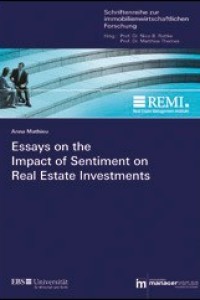Wie beeinflussen Marktstimmungen von privaten und institutionellen Immobilieninvestoren die Performance von direkten und indirekten Immobilieninvestments? Darum geht es in dieser Dissertation, die aus drei Aufsätzen besteht. „The purpose of the dissertation is to elucidate the impact of sentiment on direct and indirect real estate investments.“ (S. 5)
Dass Stimmungen und – teilweise irrationale – Emotionen die Performance von Aktien stärker beeinflussen, als es nach der effizienten Kapitalmarkttheorie der Fall sein sollte, gehört inzwischen zu den gesicherten Forschungsergebnissen, die insbesondere von dem behavioristischen Ansatz betont werden. Im Immobilienbereich hat man sich jedoch bisher weniger mit diesen Fragestellungen befasst. Es handelt sich hier also um ein Forschungsdesiderat.
Der erste der drei Aufsätze befasst sich mit dem „impact of individual and institutional investor sentiment on REIT returns“. Im zweiten Aufsatz wird untersucht, inwiefern in einer ungewöhnlichen Marktsituation, nämlich am Beginn der Finanzkrise (2007), das Sentiment von institutionellen Investoren die Volatilität und den Ertrag von Aktien- und indirekten Immobilieninvestments bestimmt. Verglichen wurden zu diesem Zweck die Auswirkungen auf US-REITs im Vergleich zum S&P 500 und zum NASDAQ-Index. Der dritte Aufsatz schließlich untersucht die Frage, wie das Sentiment von privaten Investoren, insbesondere das Konsumklima, die Verkaufszahlen von Einfamilienhäusern in den USA beeinflusst hat. Während es also in den beiden ersten Beiträgen um indirekte Immobilieninvestments (REITs) geht, werden hier direkte Immobilienanlagen untersucht.
Theoretischer Ausgangspunkt der Untersuchungen ist die sogenannte noise trader theory (S. 12 ff.). Das Ziel dieser Theorie ist es, Erklärungen für Marktanomalien – wie z. B. exzessive Volatilität – zu finden. Eine Gruppe von Investoren, nämlich die sogenannten „noise traders“, ließen sich weniger von fundamentalen Gesichtspunkten beeinflussen, sondern von irrationalen, „lauten“ Marktstimmungen. „Noise traders‘ decisions to buy, sell, or hold an asset are based on a ‚noisy‘ signal.“ (S.12) Gegen diesen Ansatz wurde von Kritikern eingewandt, zwar möge es solche Anomalien und irrational agierende „noise trader“ geben, doch würden deren Handlungen durch das Gegenwirken von Arbitrage-orientierten Investoren wieder kompensiert, sodass sie letztlich keine entscheidenden Auswirkungen auf den Markt hätten. (S. 13) Die Autorin lässt diesen Einwand jedoch nicht gelten, denn Untersuchungen belegten: „The risk aversion and the short time horizon of arbitrageurs in this model limit their willingness to take arbitrary positions and impede the complete elimination of mispricing.“ (S. 13) Das Ergebnis des ersten Aufsatzes ist, das „individual investor sentiment is a significant factor in explaining REIT returns and REIT return volatilities.“ (S. 99) Erstaunlich dabei ist, dass negative Marktstimmungen die Ergebnisse sehr stark beeinflussen, positive hingegen weniger. „Bearish sentiment increases REIT return volatility more than bullish sentiment does.“ (S. 99)
Der zweite Aufsatz vergleicht die Auswirkungen des Investor-Sentiments auf die Erträge von US-REITs, auf den S&P 500 (also large cap stocks) und auf den NASDAQ (also small cap stocks). Nicht sehr überraschend ist der Befund, dass „the impact of investor sentiment on returns and return volatility is higher during the financial crisis than in a tranquil market environment“ (S. 41). Ebenfalls nicht überraschend ist der Befund, „that noise traders‘ optimism increases their demand and provides a higher risk premium, which results in a higher return. However, if noise traders are pessimistic, they decrease their demand, lower the risk premium and reduce the return“. (S. 101)
Der dritte Beitrag untersucht, in welchem Ausmaß die Konsumentenstimmung und makroökonomische Faktoren wie die Inflationsrate, das verfügbare persönliche Einkommen und die Höhe der Zinsen die Verkaufszahlen für Einfamilienhäuser in den USA beeinflussen. Untersucht wurde dabei der Zeitraum zwischen August 1978 und August 2010. Interessant ist, dass nur zwei der fünf Variablen einen signifikanten Einfluss auf die Verkaufszahlen von Einfamilienhäusern hatten, und zwar die Konsumentenstimmung und die Höhe der Zinsen. Eine positive Konsumentenstimmung wirkt sich, wie auch nicht anders zu erwarten, deutlich positiv auf die Bereitschaft aus, Häuser zu kaufen. Und natürlich hat die Zinshöhe ebenfalls einen wichtigen Einfluss. (S. 102 f.)
Es ist zu hoffen, dass wir weitere Analysen sehen werden, die von einem behavioristischen Ansatz her Immobilieninvestments von privaten und institutionellen Investoren untersuchen. Die vorliegende Dissertation ist ein erster Ansatz, aber dennoch bleibt dies weiterhin ein Forschungsdesiderat. Da Immobilienmärkte weniger effizient sind als beispielsweise der Aktien- und der Anleihenmarkt, wäre es insbesondere sehr interessant, weiter zu untersuchen, wie sich Marktstimmungen und Emotionen auf das Anlageverhalten privater und institutioneller Immobilieninvestoren auswirken. R.Z.






